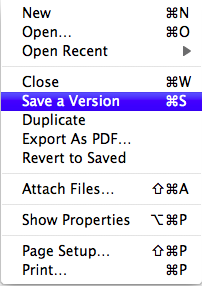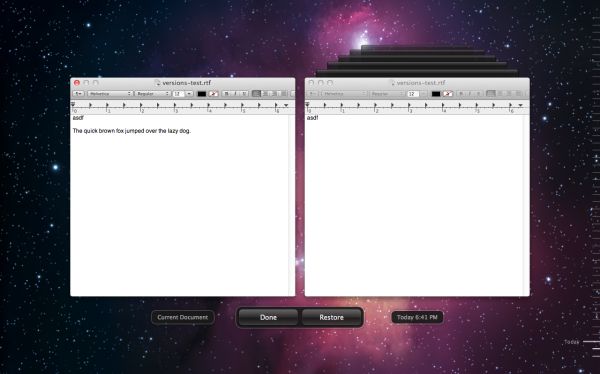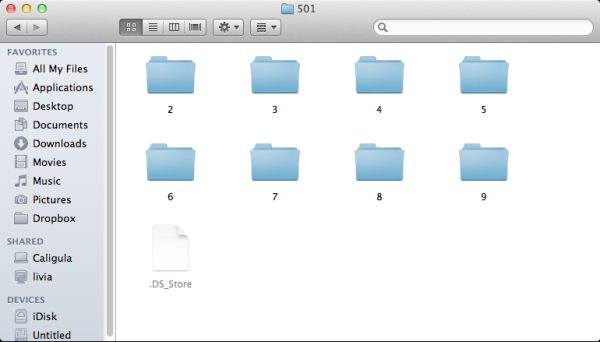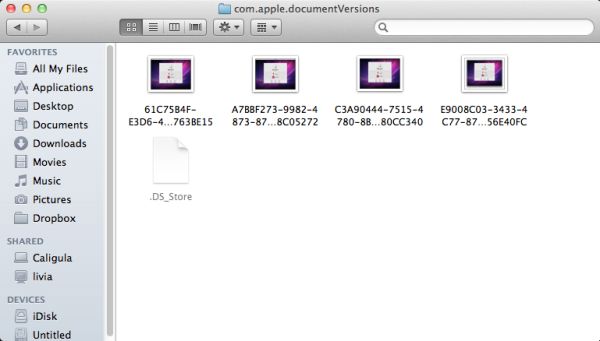Back to the Mac: OS X 10.7 Lion Review
by Andrew Cunningham, Kristian Vättö & Anand Lal Shimpi on July 20, 2011 8:30 AM ESTAnother heavily-publicized feature of Lion is Versions, which keeps older copies of files as you save new ones and allows you to go back to previous copies to compare, restore, and copy-paste things you didn't mean to change. Unlike Resume, applications will need to be changed to support this functionality.
In a Versions-supporting program like TextEdit or Preview, you'll notice that the normal "Save" or command-S function is now called "Save a Version" instead. There's no special command you need to know to save Versions - if the app supports it, this happens automatically.

When you want to go back and look at your previous versions, select the Revert to Saved option in the menu to open the Versions interface.
You'll be presented with a very Time Machine-esque interface that will let you browse through your previously saved copies, compare them to your working copy, and restore an old copy to be your new working copy.
So how does this work? Versions stores its data at the root of your OS volume in a hidden and locked-down folder called 'DocumentRevisions-V100". Files are saved using the UID for each user account (the UID is a unique number assigned to each user account at time of creation, and is normally hidden from the user. All UNIX and UNIX-like operating systems use UIDs for user accounts). In the screenshot below, "501" is my account's UID, and the numbered folders each correspond to an individual file.
Drill down into any of the folders stored here, and you can see where OS X is keeping the older copies of your files.
Whenever you delete the source file, all stored versions of it are also deleted, so don't try to use Versions to recover accidentally deleted files - that's not what it's for, and you'll still need to be careful about what you do and don't keep.
It's not immediately obvious how many files OS X will store versions for, or how much disk space this hidden folder will take up if you let it, but disk space seems to be the limitation here - I was able to save 63 versions of an individual file without overwriting any older copies. Given Apple's desire to hide the seams and inner workings of OS X from regular users, I feel confident in saying that (1) OS X won't allow this system folder to take up so much space that it impacts OS performance or storage of regular files, and (2) there's probably some sort of safeguard present that will eventually begin deleting older versions of things as disk space runs low. This is how Time Machine works, and Versions is obviously taking cues from that feature.













106 Comments
View All Comments
grahamperrin - Thursday, July 28, 2011 - link
Primarily FAO the AnandTech reviewersThank you for a very timely and useful review of FileVault 2.
The following microblog conversation links to an overview (work in progress) with some unanswered questions. Comments will be greatly appreciated.
http://identi.ca/conversation/77065575#notice-7963...
— OpenID enabled, I will welcome contributions in the Identi.ca area.
nardreiko - Tuesday, August 2, 2011 - link
And it is a big problem!The removal of Expose and Rosetta are big reasons not to "upgrade" for me both now and for the foreseeable future.
A lot of other things are clunky or ugly or annoying (like the inability to control scrolling speed in System Preferences) ... but those are minor reasons not to "upgrade".
This was a tough review to do, and I love Anandtech, but I think you guys skimmed over some very important negatives. I don't know a single person who is not an Apple employee or stock owner who claims to really like Lion ... come to think of it I haven't yet met an employee who really likes it, so it is pretty much stock owners who are saying it is an upgrade-without-quotation-marks. Although a lot of employees do genuine like the full-screen mode.
tomeg - Wednesday, October 12, 2011 - link
nardreiko said:"I don't know a single person who is not an Apple employee or stock owner who claims to really like Lion ... come to think of it I haven't yet met an employee who really likes it, so it is pretty much stock owners who are saying it is an upgrade-without-quotation-marks. Although a lot of employees do genuine like the full-screen mode."
tomeg replies:
I have a circle of nearly 200 fellow Mac users—real, (mostly) unbiased, not-at-all picky or ego-inflated (I'm not suggesting that you are), everyday-if-not-hour-intensive Mac users—and our experience has been 95% positive or enthusiastic. Some are disappointed with the loss of or change to this or that, as am I, and we have to adjust, go As The Mac OS Turns, but not one isn't glad they upgraded. Any OS must continue to be evolutionary or die. Some things go, others stay, but the overall progress is forward. I will take Lion over Windows 7 hands down this or any day. Windows has its features and (of course) fans but I'm not buying, now or ever, unless something goes massively wrong with current OS development.
bjoff - Sunday, September 4, 2011 - link
Thanks for an enlightening test! One thing I wish you had tested was the time to wake from sleep. On my macbook air (with very similar specs to your setup), it seems that waking from sleep takes a couple of seconds more with FileVault enabled. This is pretty significant when you are used to the very quick waking of Apple products...raygos - Wednesday, September 21, 2011 - link
The reviewer complains that Resume can be annoying for the likes of him/her when a clean slate is desired. He/she writes: "I found myself pressing command-W a bunch of times to close windows before I'd press command-Q to quit the program." There is, of course, the shortcut command-option-W to close all open windows in the active application. For mousers, press option while clicking the red "close window" button does the same thing. Gotta save those clicks!dtalari - Friday, October 28, 2011 - link
I am a work-study at a college and we recently bought a bunch of IMACS to make an IMAC Labs for all the students. We also have a few for the staff. We had Snow Leopard installed initially and we were able to connect perfectly fine to all of the servers within our network,however since our implementation of lion the servers don't show up under the shared tab in the finder automatically like before. The computers on the network show up but not the servers. Anyone have any ideas as to why? I figured it has something to do with samba not being implemented as it was in Snow Leopard? Is there any easy way to change a setting? Or do I have to manually add each server to each computer?Thanks